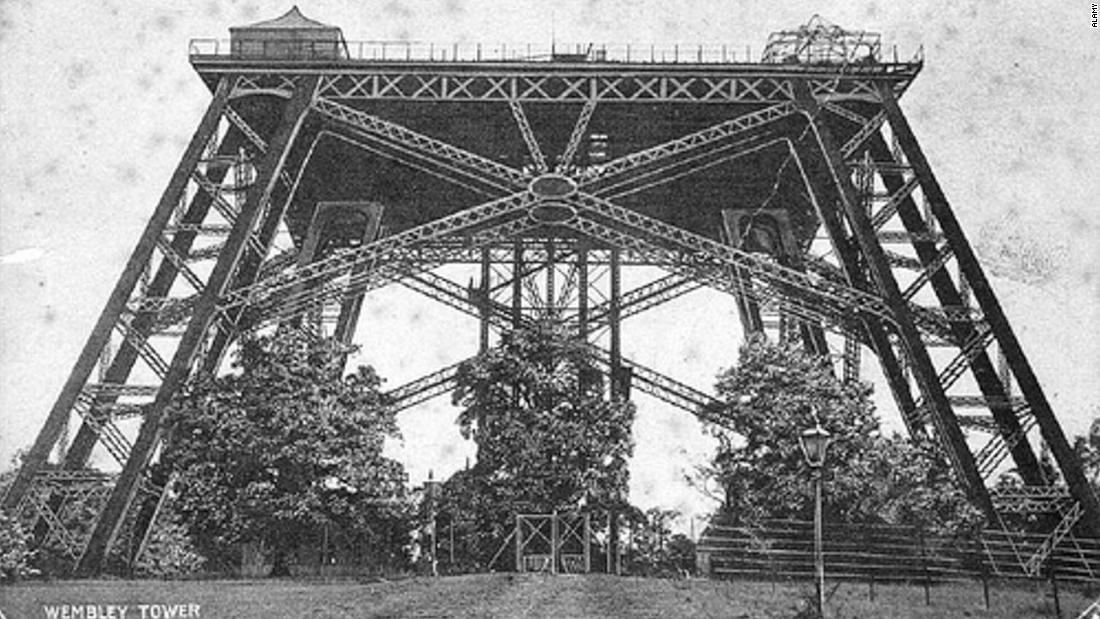
(CNN) — Somewhere beneath the pitch of England’s countrywide stadium in Wembley, London, lie the foundations of what could have been the city’s tallest setting up. Motivated by the Eiffel Tower in Paris, the Terrific Tower of London was poised to surpass it in peak and reach nearly 1,200 toes.
Instead, it never ever went previous the to start with development phase, which arrived to be identified as the “London Stump.” It was demolished just about 120 several years ago, leaving guiding an unfulfilled desire and massive concrete foundations that were being rediscovered in 2002, when the recent stadium was created to exchange an older a person.
So what went completely wrong?
The tower was the brainchild of Edward Watkin, a British politician and railway tycoon whose preceding endeavors bundled a unsuccessful attempt to construct a tunnel less than the English Channel, extra than 100 yrs prior to the present Eurotunnel commenced construction.
‘Bigger the better’
A person of the tower designs that failed to get picked.
The Community Area Overview
“Watkin was a born entrepreneur and he liked significant thoughts — the more substantial the improved,” says Christopher Costelloe, an qualified on Victorian architecture and an inspector of historic structures at community heritage organization Historic England. “I believe he had a inclination to get so energized with his tips that he often plowed ahead prior to wondering about how practical or monetarily viable they ended up.”
The Eiffel Tower, which opened in 1889, speedily became a well-liked tourist attraction and its design expenses have been recouped in a subject of months.
At the same time, Watkin was looking for strategies to catch the attention of extra passengers onto his Metropolitan Railway — which would later become the Metropolitan line on the London Underground.
The railway handed via Wembley, then a rural hamlet northwest of central London, wherever Watkin had bought land to create an amusement park: “It was meant to be the Disneyland of its working day, or the successor to the early 19th-century leisure parks like Battersea Park in London or Tivoli Gardens in Copenhagen,” claims Costelloe.
What much better than a tower taller than the Eiffel to persuade Londoners to board a teach to get there?
Watkin had the audacity to ask Gustave Eiffel himself to structure it, but the French engineer refused on patriotic grounds. His strategy B was an international style level of competition, with a to start with prize of 500 guineas, about $80,000 in today’s cash.
He acquired 68 submissions, not all of them real looking.
One particular was 2,000 ft tall and was intended to have a educate working midway to the major, on a spiraling railway. Another was intended as an “aerial colony” with sky gardens, museums and galleries, as effectively as a reproduction of the Terrific Pyramid at the top rated.
Most, however, matched the aesthetics of the Eiffel, and it was 1 of these that Watkin picked as the winner, submitted by London architects Stewart, McLaren and Dunn.
“The profitable proposal was a extra slender model of the Eiffel Tower. Incredibly related in its total profile, but the composition was sort of skinnier,” suggests Costelloe. At 1,200 toes, it was also about 175 toes taller than its Parisian counterpart, which was the world’s tallest making at the time.
A not-so-well-known attraction

The initial, and only, finished stage of the tower.
Alamy
All entries have been gathered in a catalog, posted in 1890, which explained the venture in element and exposed that the London tower would be “a lot far more spacious” than the Eiffel and incorporate “eating places, theaters, shops, Turkish baths, promenades, winter gardens and a variety of other amusements,” all reachable by means of a the latest creation, the electrical elevator. An observation deck would present panoramic views and astronomical observations, facilitated by the “purity of air” identified at these an “enormous top.”
Following the preliminary fanfare, nevertheless, the proposed design was scaled down to make it more affordable to build, and the legs were being diminished from the original 8 to four, the exact variety as the Eiffel.
Design started in 1892, and the initially stage — about 150 ft tall — was finished three many years later on.
Wembley Park experienced opened the yr ahead of and was having fun with reasonable success, but the tower continue to experienced a lengthy way to go — and there was anything erroneous with it.
“When they reached the first phase, it quickly turned crystal clear that the building was subsiding. Not so badly that they couldn’t use it, but they definitely realized they’d have significant issues if they carried on creating it higher, raising the pressure on the legs,” claims Costelloe.
While it was opened to the general public and elevators were put in, the tower was doomed.
“A single of the most important problems was that Watkin died in 1901,” Costelloe adds. “He experienced been the driving power guiding the project and with his loss of life all that was still left was a rational calculation of expenditures and gains. Men and women could go up to the 1st phase, but that wasn’t really substantial adequate to get the form of panoramic views you would get from the best of the Eiffel Tower, and the encompassing spot was not especially developed or amazing.
“There just weren’t enough site visitors to pay back for finishing it.”
Tallest in city

When Watkin died, the impetus for developing the tower was lost.
Herbert Barraud/Hulton Archive/Getty Visuals
A 12 months after Watkin’s dying, the tower was declared unsafe and closed down. Shortly following, it was demolished with dynamite. The surrounding Wembley area, however, ongoing to flourish as an industrial and household London suburb.
In 1923, a stadium, which would later be known as the initial Wembley Stadium, was erected on the former web-site of the tower. Its demolition to make way for the recent Wembley Stadium inevitably unearthed the tower’s foundations, when work to decreased the amount of the new pitch was undertaken. It was a late reminder of the unsuccessful tower, also referenced by a pub in the location named “Watkin’s Folly” (it shut completely in 2019).
Remarkably, Watkin’s Tower would nonetheless be London’s tallest setting up now, surpassing The Shard skyscraper by virtually 160 feet. But would it be an legendary landmark like the Eiffel Tower? Probably not, states Costelloe: “It would continue to have been a quite major composition on the skyline, but witnessed only in particular views,” he states.
“Not currently being in the heart of London, it would never have had the form of dominating concentration that the Eiffel Tower has in Paris.”





